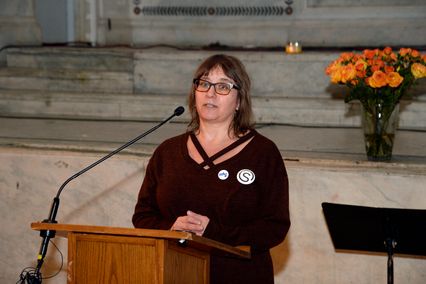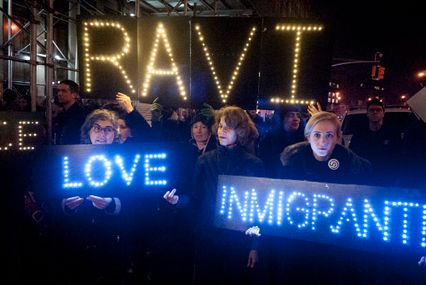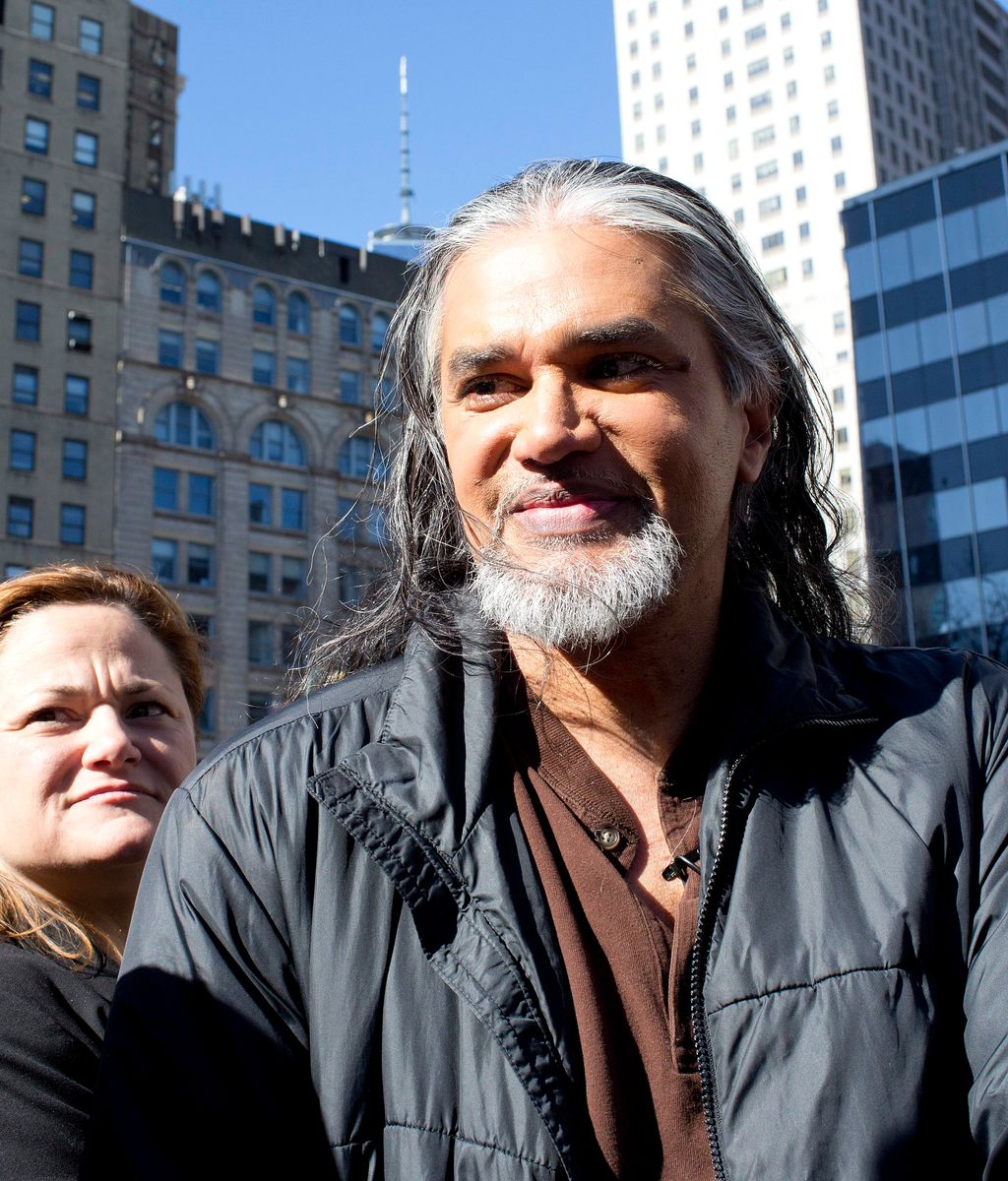“Today is going to be extremely anxious,” Ravi Ragbir told everyone over bagels and doughnuts at Judson Memorial Church in lower Manhattan. He was about to check in with U.S. Immigration and Customs Enforcement — and the stakes couldn’t have been higher.
Later, looking down from the cafeteria on the sixth floor of ICE’s New York field office at 26 Federal Plaza, Ragbir’s gathered supporters — his family, his legal team, faith leaders, and public officials — could see a large crowd of people walking in silent support of his case, forming a thick line that snaked around the corner of the building.
After another prayer circle, Ragbir gave out more hugs before putting a fedora back on his head. He said his goodbyes provisionally; he hoped to see everyone again afterward, so they could have a celebratory drink if he was given another stay of deportation.
“We ready?” Alina Das, Ragbir’s lead attorney, asked, walking toward the exit. It was time to check in. At around 9:45 a.m., Ragbir walked out of the cafeteria, not knowing whether it would be for the last time. He, his wife, and his legal team took the short elevator ride upstairs to the tenth floor. On the faded blue doors that led to the offices where Ragbir would have his check-in, there was a torn poster for ICE’s peer-support program. “You are not alone,” it read. “We are here to listen …”
For about two-thirds of Ragbir’s 27 years in the U.S., he has been in legal limbo. A native of Trinidad and Tobago who became a permanent resident of the U.S. in 1994, he has been fighting an order for his deportation since 2000, stemming from a conviction that year for wire fraud and conspiracy. Ragbir has since become one of the most prominent immigration-rights activists in America: He is the executive director of the New Sanctuary Coalition of New York City, an interfaith network that supports undocumented immigrants at court proceedings and check-ins with ICE — a blueprint for activists nationwide. (Full disclosure: I have volunteered for the organization.)
Though Ragbir had been granted stays of deportation before, the mood of this latest check-in felt fraught: A week before, Jean Montrevil, a co-founding member of New Sanctuary, had been detained on his way to work, and was then facing deportation to Haiti over a 28-year-old conviction for the possession of cocaine. (He would be deported soon after, on January 16.)
Ragbir’s story drew national attention last March during his first check-in under the Trump administration, when activists led large crowds in a march around the ICE building on Federal Plaza. But public attention also brought higher stakes; Ragbir’s team worried that ICE might try to make an example of him. “It’s scary checking in with Ravi, because we organize his check-ins to be very high-profile to expose what check-ins are,” said Rhiya Trivedi, a member of Ragbir’s defense team. “More than anything, it’s terrifying.”

Ragbir’s check-ins are most nerve-racking for Amy Gottlieb, his wife of more than seven years. When they were first married, Ragbir was wearing an ankle monitor, checking in weekly with the company that operated it. His later check-ins, with ICE, happened every six months or annually. “It’s really hard for me,” Gottlieb said. “I fully support his openness, his decision to do this publicly. It’s really important for the world to know.”
Ragbir’s saga has coincided with a shift in the way the U.S. government polices immigrants. President Barack Obama oversaw the forcible removal of more than 3 million undocumented immigrants — far outpacing the Bush and Clinton administrations — while his successor, Donald Trump, has overseen a 30 percent spike in ICE administrative arrests during his first fiscal year in office. (Gottlieb will be at President Trump’s first State of the Union address, invited by New York representative Nydia Velázquez; the speech comes on the heels of a surprise White House immigration proposal that almost seems designed to make a deal impossible.)
Ragbir was, at moments, visibly shaken as his check-in neared. Jean Montrevil’s detainment had put everyone on edge, and no one more so than Ragbir, who said he had woken up one recent morning weeping uncontrollably.
“When they picked up Jean,” Ragbir told me, “it was a signal that I’m next.”
Ragbir has insisted that he doesn’t want to be a symbol — that the movement to which he’s dedicated his time in the U.S. will always be bigger than any one person. But he has become a symbol nonetheless. His case is perhaps the most prominent example to date of what seems to be a sharpened focus on the immigration status of immigrant-rights leaders with nonviolent convictions. Ragbir and Montrevil’s convictions were almost two and three decades ago, respectively. Their supporters ask: Why are these men a priority for deportation now? Is the administration trying to deport some of its most vocal critics? Motives aside, immigration activists argue that only a flawed immigration process and legal system could have produced a situation like Ragbir’s.
Growing up in Trinidad, Ragbir, the son of two elementary-school teachers, would plow through two or three full-length books a day. He jokes that all that reading never translated into studying or doing his homework. Though he grew up without access to running water, Ragbir, along with his two sisters, recalls never feeling poor, which he credits to his parents’ insistence that they focus on academics. “I was what you call a nerd,” he told me.
In 1991, Ragbir came to the U.S. on a visitor’s visa. He never expected to come stateside, but he wanted to improve his education. (He says he studied financial management at Baruch College, but did not finish his degree.) In 1994, Ragbir became a lawful permanent resident; the next year, his daughter, Deborah, was born. In order to support his new family, he says he took on whatever job he could, from risk manager to financial planner to dabbling in real estate and notary work.
In 1999, Ragbir was working for a now-defunct mortgage lender as a low-level telemarketer. While on the job, he says, he was approached by a broker who submitted loan applications to him. He then passed them on to his company, believing the paperwork to be legitimate. But it wasn’t. When the broker was arrested and later indicted for wire fraud and conspiracy, several employees involved in those applications were also charged, including Ragbir, who was convicted in 2000 and sentenced to 30 months in prison. In 2006, he was transferred to detention, where an immigration judge ordered that Ragbir be removed based on his conviction.
While in detention, Ragbir found his political voice, and began organizing for inmates’ rights. Once he was released from the deportation proceedings in 2008, Ragbir turned to the immigration-rights movement. That year, he did a phone interview with his future wife, Gottlieb, a longtime immigrant-rights activist, for a radio show on immigration he’d begun producing.
“He hadn’t been out of detention very long, but he really dove into the movement,” Gottlieb recalls. “Suddenly, he was this presence. Everywhere I went, there was Ravi.” Two years later, they were married.
Gottlieb told me she holds onto the moments she described as “hokey,” such as going to dinner with her husband in downtown Brooklyn and taking walks near Brooklyn Bridge Park. Gottlieb glowed when reflecting on how they’d go under the nearby fishing pier on a nice night to watch the tugboats go by. It’s that peacefulness and sense of normalcy that they fight for in their messy activist lives.
“I want it to be over,” Gottlieb told me of her husband’s situation. “I want Ravi to be home at night. I want us to hole up in our apartment over the weekend and get takeout and watch movies and just be.”
ICE check-ins are annual or biannual meetings between undocumented immigrants and federal agents which are meant to demonstrate a person’s ties to the U.S., and prove that nothing has changed since their last meeting. Once seen as perfunctory, these meetings have become much more threatening in recent years, as stories have spread of people being surprised with detention and deportation.
It was this fear that had Ragbir’s group of supporters gathering in a tense knot in the corner of the Federal Plaza cafeteria as they awaited an update on his check-in, nervously discussing contingencies. A little over 20 minutes later, Trivedi received the verdict by text.
“No,” she said in disbelief. “No!” Still staring at the screen, she confirmed the news. “It looks like Ravi is going to be taken in.”
Soon, Trivedi was sprinting down the hall outside the cafeteria, instructing a colleague to pass a message to file a new federal lawsuit challenging ICE’s actions against Ragbir.
“File everything,” she said, hurriedly. “They’re taking him in.”
As the news filtered into the crowd outside, police began wrestling protesters to the ground and binding their wrists together with zip ties. We later found out that Ragbir had fainted when he was told he was being detained; he left the building in an ambulance, accompanied by his wife. But when they got to the hospital, Gottlieb said, ICE agents ordered her out. “That’s the last time I saw him,” she told family and friends in the lobby of New York-Presbyterian Lower Manhattan Hospital.
Ragbir’s team was ready. In addition to a pending case in New Jersey federal court to vacate his criminal conviction, they filed a new lawsuit to not just examine ICE’s actions, but also to see whether Ragbir could be given a temporary stay of removal.
Hours after Ragbir was taken into custody, the team discovered — using ICE’s online detainee-locator system — that Ragbir was at the same Miami detention center that was housing Montrevil before deportation. Later, Ragbir would be moved to a facility in Orange County, New York.

In a statement to Daily Intelligencer, ICE reiterated its stance on Ragbir’s case. “In each review, the courts have uniformly held that Mr. Ragbir does not have a legal basis to remain in the U.S.,” says Rachael Yong Yow, the public affairs officer with ICE’s New York office. “In an exercise of discretion, the agency had previously allowed him to remain free from custody with periodic check-ins while his case was under court review. He has since exhausted his petitions and appeals through the immigration courts, the Board of Immigration Appeals, and the U.S. District Court. He will remain in custody pending removal to Trinidad.”
However, when the case Ragbir v. Sessions got a court hearing on January 29, Ragbir was released from detention with a temporary stay. In her ruling, Manhattan Federal Court judge Katherine Forrest granted the habeas petition filed by Ragbir’s defense team, saying that his rights to due process were violated by ICE agents at his check-in. Ragbir is “entitled to the freedom to say goodbye,” Forrest wrote. “This abrupt and by all accounts unnecessary detention, a step in the direction of deportation, was wrong. We as a country need and must not act so. The Constitution commands better.”
The evening of Ragbir’s initial detainment, hundreds had gathered outside the entrance of the immigration court at 201 Varick Street to support him. An emotionally drained Gottlieb stood among the crowd; the TV interviews and chants with faith leaders and activists were a long way off from those times when she’d watch the tugboats pass by with the love of her life.
“My gut is telling me this struggle time is not over,” she told me. “I do think there is going to be a happy ending to this. I have to hold on to that.”






























